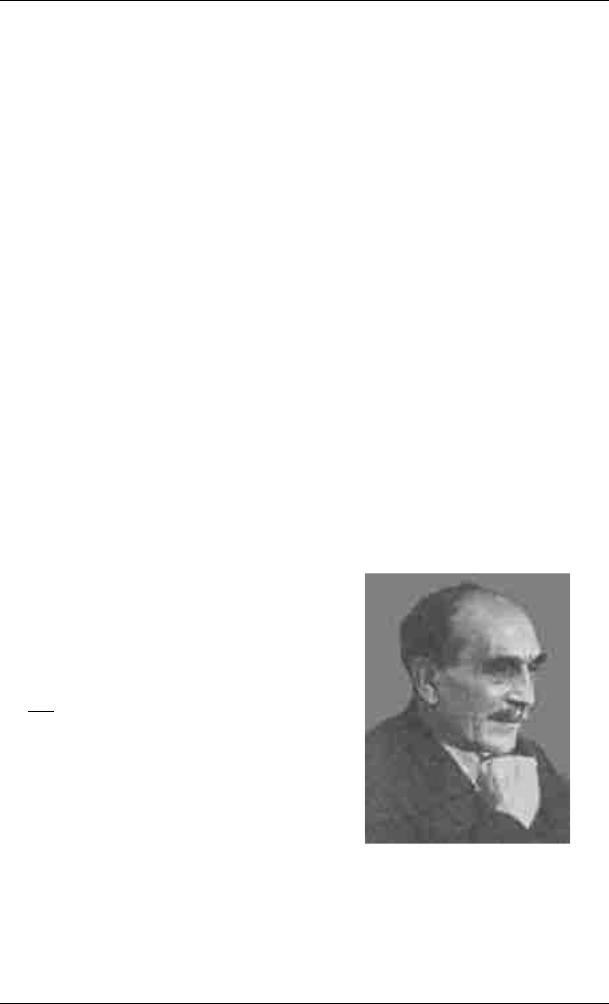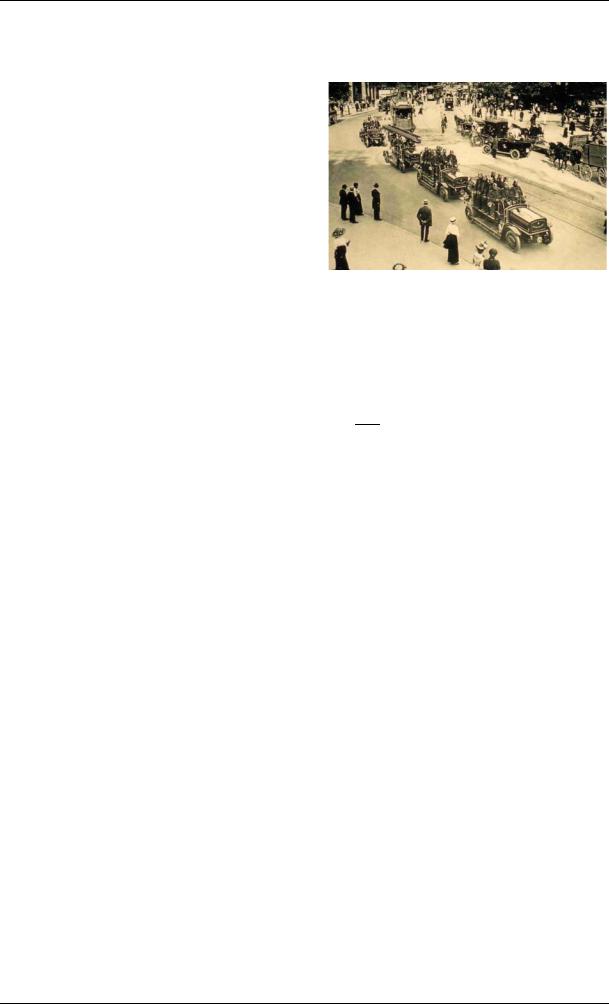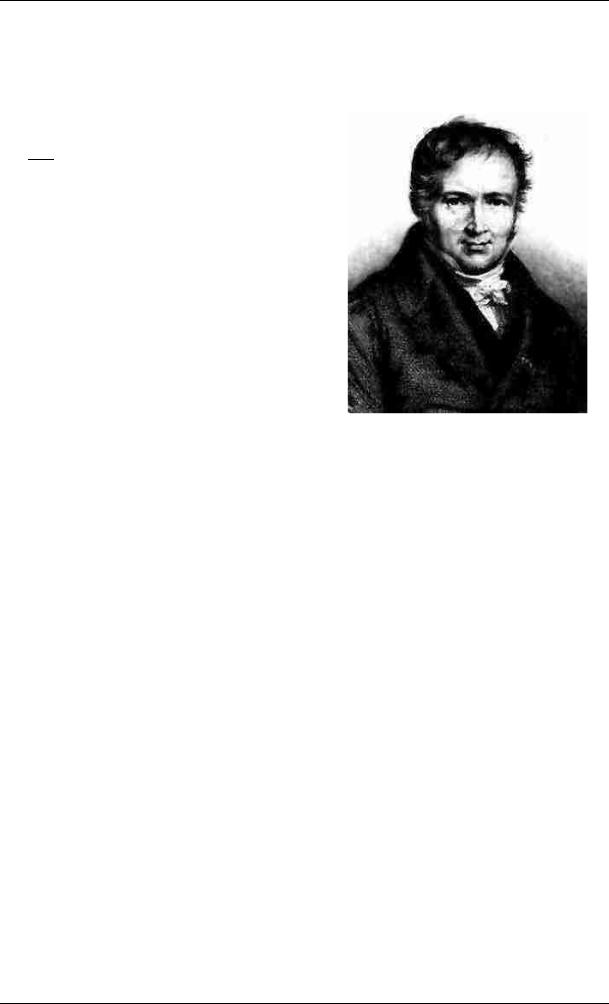
Статистика пожаров / Центр пожарной статистики CTIF / ctif_report10_world_fire_statistics_2005
.pdf
World fire statistics / Мировая пожарная статистика / Weltfeuerwehrstatistik
пассивных и активных средств борьбы с пожарами.
22.4 
 - Wissenschaftlich-technische Probleme der Brandsicherheit auf der Welt
- Wissenschaftlich-technische Probleme der Brandsicherheit auf der Welt
In diesem Abschnitt betrachten wir in aller Kürze die grundlegenden und gleichzeitig widersprüchlichen Tendenzen in der Entwicklung der Brandsicherheit und des Niveaus der Brandrisiken auf unserem Planeten.
Fig. 22.4-5: Fire-fighting in Baltimore (USA) 1904
Auf der einen Seite wird die uns umgebende Welt durch die sich beschleunigende wissenschaftlich-technische Entwicklung der gegenwärtigen Zivilisation immer brandgefährlicher. Insbesondere nimmt der Energieverbrauch in Industrie und Haushalt ständig zu, was mit wachsender Zahl von Gerätschaften, zunehmender Komplexität der technologischen Prozesse, der Lagerung, Transport, Weiterverarbeitung von Produkten verbunden ist.
All dies und vieles mehr führt zum weiteren Anwachsen der Brandrisiken in der Weltwirtschaft.
Auf der anderen Seite bringt der gleiche wissenschaftlich-technische Fortschritt immer wirksamere Mittel und Methoden zur effizienten Brandbekämpfung hervor. Es ist wichtig, eine ausgewogene Wechselwirkung zwischen diesen beiden Prozessen zu erreichen. Der zweitgenannte Prozess muss im Vergleich mit dem zuerst genannten Prozess um einiges weiterentwickelt sein oder zumindest diesem in der Entwicklung nicht nachstehen. Der technische Fortschritt darf nicht mehr Probleme erzeugen, als er selbst zu lösen vermag. Das ist eine strategische Aufgabe, die mit der schrittweisen Minderung aller Brandrisiken und der Gewährleistung der Brandsicherheit auf der Welt einhergeht.
Dazu müssen folgende Bedingungen erfüllt sein:
wenn die Menschheit erstens eine hinreichend vollständige Vorstellung über die schon
existierenden und noch zu schaffenden Stoffe, Materialien, Produkte und die technologischen Prozesse hat,
wenn zweitens die Regeln und Vorschriften zur Brandvorbeugung und Brandverhinderung von allen Menschen in Produktion und Haushalt eingehalten werden,
wenn drittens in allen Bereichen hinreichend zuverlässige und effektive Systeme der Branderkennung und wirksamen Brandbekämpfung existieren und
wenn es viertens in den menschlichen Siedlungsgebieten gut ausgebildete und
technische ausgerüstete Feuerwehren gibt, kann man die Brandgefahren der uns umgebenen Welt prognostizieren und kontrollieren, um somit alle Brandrisiken planmäßig bis auf ein annehmbares Niveau zu senken.
Die Welt wurde also bis zur heutigen Zeit immer brandgefährlicher.
Der Umfang und Schwierigkeitsgrad aller Arbeiten zur Gewährleistung einer von Bränden gefährdeten Welt nimmt ständig zu. Ebenso wachsen die damit verbundenen Ausgaben. Es ist notwendig, das theoretische Wissen im Bereich des Brandschutzes unter Nutzung der Erkenntnisse aller grundlegenden Wissenschaftszweige und ihrer praktischen Anwendungsgebiete weit tiefgründiger zu erweitern.
Fig. 22.4-6: Berlin Fire Brigade in 1930
Fig. 22.4-7: Berlin Fire Brigade in 1910
Hierbei ist es erforderlich, eine allgemeine Theorie der Gewährleistung der Brandsicherheit in allen menschlichen Tätigkeitsbereichen (Industrie, Haushalt, Freizeit) zu schaffen. Dies erfordert eine entsprechende juristische, organisatorische und
Report №10 – CFS of CTIF |
120 |
INTERSCHUTZ 2005 |

World fire statistics / Мировая пожарная статистика / Weltfeuerwehrstatistik
materiell-technische Unterstützung durch die Politik sowie die internationale Zusammenarbeit im Bereich der Brandvorbeugung und –bekämpfung.
Unter dem Begriff „Allgemeine Theorie der Gewährleistung der Brandsicherheit“ verstehen wir die Gesamtheit aller physikalisch-chemischen, mathematischen, wirtschaftsmathematischen und anderer Modelle der Brandentstehung, Brandentwicklung und Brandbekämpfung innerhalb und außerhalb von Gebäuden sowie des Schutzes von Menschen, Tieren und der Umwelt vor den gefährlichen Brandfaktoren unter den Bedingungen passiver und aktiver Schutzmaßnahmen gegen Brände.
22.5 
 - Formation of the theoretical basis of ensuring fire safety
- Formation of the theoretical basis of ensuring fire safety
As each fire is connected with the initiation of burning processes, and as each firefighting operation is connected with a targeted interruption of these combustion processes, these processes shall form the basis of the strategy to ensure fire safety.
Fig. 22.5-1: Fire Fighters in Ukraine in 1924
From its very beginning, the human civilisation has tried to understand the nature of burning processes. However, it could be discovered only in the mid of the 18th century that combustion processes are to be explained in view of the interrelations between combustible substances and oxidants (as a rule atmospheric oxygen). This was the beginning of the scientific research of the phenomenon “fire“.
First, the field of science examining combustion processes was a field of chemistry. During that stage, experimental data were collected about the character of oxidation reactions, thermal effects and the propagation of flames. During further stages, the development of engineering and technology (in particular of technologies for ignition of substances) led to significant needs in knowledge regarding a specific aspect of combustion processes – the combustion rate.
At the end of the 19th century, a special field of chemistry was born – the science on the rates of chemical conversion processes (kinetics). From that moment on, the knowledge on combustion processes became an independent field of science, providing the opportunity to make use
of a consolidated apparatus of mathematic analysis (differential and integral calculus) as well as of the differential equation theory (general differential equations / partial derivatives).
Fig. 22.5-2: Fire-fighting Tender in Russia (1865)
In the course of the 20th century, the theory on the combustion processes underwent an intensive development and improvement – coming to a series of important achievements. This scientific progress is very closely connected with the work of the Nobel Prize winner N.N. SEMYONOV (1896-1986). However, many combustion mechanisms are still not sufficiently investigated. While the theory about combustion processes as an independent field of science was created at the end of the 19th century, the creation of the theory about ensuring of fire safety can be dated to mid of the 20th century. This theory is based on different fire models, covering all classes and types of fire, related to outbreak of fire, fire development and fire fighting.
Around mid of the 80ies of the 20th century, the American scientist EMMONS (19121998) published a quite interesting article “The Future of the Science on Fire“, predicting that the main scientific problems related to the investigation of fire, it dynamics und consequences will be solved only towards the 23rd/24th century. The argumentation of Mr EMMONS in this respect seems to be sufficiently convincing:
He wrote: „We can imagine the years 1950 to 2000 being a period, in which the basic ideas of the fire science were initiated, the existing fire components were identified and their fundamental character investigated, during which the world recognized the necessity to set up the society’s fire safety on the basis of engineering norms that consider the laws of fire development, making the first steps towards realisation of this task.ù
Let us return to this article later. We shall state here, that different countries started with a professional investigation of fires and their dynamics during the second half of the 20th century. New methods and tools of fire-fighting were developed and applied. Problems of fire protection of certain objects and in cities were intensively discussed. The science on fire reached an accepted position among the applied sciences, developing towards an interdisciplinary science. It is quite difficult at current stage to quote a field of science,
Report №10 – CFS of CTIF |
121 |
INTERSCHUTZ 2005 |

World fire statistics / Мировая пожарная статистика / Weltfeuerwehrstatistik
the research methods of which are not applied for solving fire protection problems.
Question: What is happening during a fire? Just imagining that in a certain room a fire breaks out. The room takes over the heat quantity released, the temperature increases, combustion products emerge (including toxic components). A part of the heat disappears into environment together with the combustion products. Another part of the heat is accumulated by combustible and non-combustible materials that exist in the room. These are materials, which form the building construction, certain technical equipment and appointments. As soon as the combustible components have heated the room up to a specific temperature, they ignite and burn. The non-combustible parts of the material and construction change their properties and mechanical stability. On certain conditions, they loose their load-bearing or room sealing characteristics. So, the fire can spread to neighbourhood rooms, the whole building or even to neighbourhood buildings.
In order to minimise the negative consequences of a fire, it is necessary to detect a fire as soon as possible, thus being able to initiate fire-fighting measures at earliest stage, to arrange the evacuation of people as well as the rescue of animals, and to recover material values and intangible assets.
The analysis of all aforementioned phenomena and processes requires the application of different methods belonging to physics, chemistry, physical chemistry, chemical physics, thermodynamics, mechanics of solid, liquid and gaseous substances, the theory on material resistance, physiology, toxicology, psychology, sociology, economy and – of course - mathematics.
The investigation of the complex processes related to the phenomenon "fire" and the description of the initiation, development and extinguishing of fires require the application of the whole scientific apparatus and the involvement of findings coming from different fields of science – we speak here about fire models.
22.5 
 - Формирование теоретических основ обеспечения пожарной безопасности
- Формирование теоретических основ обеспечения пожарной безопасности
Поскольку всякий пожар связан с возникновением и развитием процесса горения, а его ликвидация означает целенаправленное прекращение этого процесса, то научные основы процессов горения составляют фундамент научных основ обеспечения пожарной безопасности.
Человечество издавна пыталось постичь сущность процессов горения, их природу. Однако только в середине XVIII в. удалось выяснить, что в основе их лежит процесс взаимодействия горючего вещества и окислителя, в качестве которого в этом процессе обычно участвует кислород воздуха. Так был установлен научный взгляд на горение.
Сначала наука о горении развивалась как один из разделов химии. В этот период накапливались экспериментальные данные о характере реакций окисления, о составе продуктов горения, его тепловом эффекте, распространении пламени. В дальнейшем потребности быстро развивающейся техники, в частности, техники сжигания, дали импульс в разработке особенно важной стороны горения –
скорости этого процесса.
Вконце XIX в. возникает специальный раздел химии – учение о скоростях химических превращений (кинетика). С этого момента учение о горении начало оформляться в самостоятельную научную дисциплину и получило возможность использовать мощный аппарат математического анализа (дифференциальное и интегральное исчисления)
итеорию дифференциальных уравнений (обыкновенных и с частными производными).
Вºº в. теория горения развивалась чрезвычайно интенсивно и добилась значительных успехов, которые во многом связаны с именем лауреата Нобелевской премии Н.Н. СЕМЕНОВА (1896-1986 гг.) Однако и в конце ХХ в. механизмы многих процессов горения изучены недостаточно полно.
Если теория горения как самостоятельная научная дисциплина возникла в конце XIX в., то возникновение теории обеспечения пожарной безопасности уместно отнести к середине ХХ в. Ее основу составляют разнообразные модели пожаров всех классов и типов, их возникновения, развития и ликвидации.
Fig. 22.5-3: N.N. SEMJONOW (1896-1986)
В середине 80-х годов американский ученый ЭММОНС (к сожалению, недавно ушедший из жизни) опубликовал интересную статью «Дальнейшая история науки о пожаре», в которой он предсказал, что основные научные проблемы, связанные с изучением пожаров, их
Report №10 – CFS of CTIF |
122 |
INTERSCHUTZ 2005 |

World fire statistics / Мировая пожарная статистика / Weltfeuerwehrstatistik
динамикой и последствиями, будут решены только к XXIII - XXIV столетиям нашей эры. При этом аргументация ЭММОНСА выглядит достаточно убедительно. Эммонс писал:
«Мы можем представить годы с 1950 по 2000 как период, в котором были развиты основные идеи науки о пожаре, когда были идентифицированы все существенные компоненты пожара и выяснен их фундаментальный характер, была осознана необходимость основывать пожарную безопасность общества на базе создания расчетных противопожарных норм, учитывающих законы развития пожара, и были предприняты первые шаги по реализации этой задачи».
К этой статье мы еще вернемся. Пока же заметим, что, действительно, начиная со второй половины ХХ в. все больше исследователей в разных странах мира стали профессионально изучать пожары, их динамику, разрабатывать новые способы, методы и средства борьбы с пожарами, вопросы проектирования систем противопожарной защиты объектов и городов. Наука о пожарной безопасности заняла свое место среди прикладных наук, носящих междисциплинарный характер. Сегодня трудно указать научную дисциплину, методы которой не использовались бы при решении проблем пожарной безопасности.
В самом деле, предположим, что в каком-то помещении возник пожар. В помещении нарастает количество выделяющегося тепла, растет температура, появляются продукты горения, включая их токсичные компоненты. Часть тепла рассеивается в виде продуктов горения в окружающем пространстве. Другая часть аккумулируется горючими и негорючими материалами, находящимися в помещении. Из них состоят и строительные конструкции, и различные предметы, и оборудование. Нагреваясь до определенной температуры, сгораемые конструкции, предметы и оборудование воспламеняются и горят, а несгораемые материалы и конструкции изменяют свойства, теряют механическую прочность и при определенных условиях разрушаются. Пожар может распространиться в соседнее помещение, охватить все здание, переброситься на соседние здания.
Чтобы минимизировать последствия пожара необходимо как можно быстрее обнаружить его, принять меры к ликвидации пожара, обеспечить эвакуацию людей, животных, материальных и духовных ценностей.
Для того чтобы проанализировать все перечисленные явления и процессы, нужно использовать методы общей физики, химии, физической химии, химической физики, теплофизики, механики твердых тел, жидкостей
и газов, сопротивления материалов, физиологии, токсикологии, психологии, социологии, экономики и, конечно, математики.
Fig. 22.5-4 Fire vehicles of the Berlin Fire Brigade in 1910
Только с помощью комплекса этих (и других) научных дисциплин можно изучить и описать все сложнейшие явления и процессы, сопровождающие возникновение, развитие и ликвидацию пожара, т.е. построить его модель.
22.5 
 - Entstehung der theoretischen Grundlagen zur Gewährleistung der Brandsicherheit
- Entstehung der theoretischen Grundlagen zur Gewährleistung der Brandsicherheit
Da jedes Feuer oder Brand mit der Entstehung von Verbrennungsprozessen, sowie jede Brandbekämpfung mit der gezielten Unterbrechung eben dieser Prozesse verbunden ist, müssen diese das Fundament der Gewährleistung der Brandsicherheit sein.
Die Menschheit hat seit jeher versucht, das Wesen der Verbrennungsprozesse zu erkennen. Gleichwohl gelang es erst Mitte des XVIII. Jahrhunderts zu bestimmen, dass die Grundlage der Verbrennungsprozesse in den Wechselbeziehungen zwischen brennbarem Stoff und dem Oxidationsmittel, in der Regel der Sauerstoff der Luft, zu suchen ist. So entstand der wissenschaftliche Gedankenansatz zur Erforschung des so genannten Phänomens „Feuer“.
Zuerst entwickelte sich die Wissenschaft über die Verbrennungsprozesse als ein Teilgebiet der Chemie. In dieser Zeit wurden experimentelle Daten über den Charakter der Oxidationsreaktion, den Wärmeeffekt und der Ausbreitung von Flammen gesammelt. Im Weiteren wuchs, auf Grund der sich entwickelnden Technik (insbesondere von Technologien zum Entzünden von Stoffen) der Bedarf an Wissen zu einer besonderen Seite der Verbrennungsprozesse – der Verbrennungsgeschwindigkeit.
Ende des XIX. Jahrhunderts entstand ein spezifisches Fachgebiet der Chemie – die Lehre von den Geschwindigkeiten chemischer Umwandlungsprozesse (Kinetik). Von diesem Moment an formierte sich das Wissen um die Verbrennungsprozesse als eigenständige
Report №10 – CFS of CTIF |
123 |
INTERSCHUTZ 2005 |







 - Fire modelling
- Fire modelling - Моделирование пожаров
- Моделирование пожаров